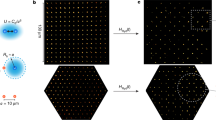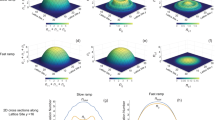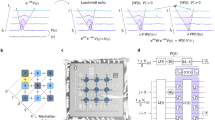Abstract
Quantum simulation provides platforms to study fundamental aspects of many-body physics in a controlled way, and to explore their implications for quantum technology. However, the dimension of the Hilbert space grows exponentially with the number of interacting particles, which means that investigations of strongly correlated problems such as quantum criticality and many-body localization in terms of few-body probes in real space are often insufficient. Here we demonstrate how to tackle such questions on a superconducting quantum processor from a Fock-space perspective. We map a many-body system onto an unconventional Anderson model on a network of many-body states, which allows the direct observation of wave-packet propagation in Fock space. We find a quantum-critical regime of anomalously enhanced wave-packet width and deduce a critical point from the maximum wave-packet fluctuations, which lends support to the two-dimensional many-body localization transition in finite-sized systems. Our results introduce an alternative picture for characterizing many-body dynamics and for exploring the controversial problems such as criticality and dimensionality. Moreover, the protocol is universal and scalable, and is therefore a promising strategy to solve a broader range of many-body problems on future quantum devices.
This is a preview of subscription content, access via your institution
Access options
Access Nature and 54 other Nature Portfolio journals
Get Nature+, our best-value online-access subscription
27,99 € / 30 days
cancel any time
Subscribe to this journal
Receive 12 print issues and online access
269,00 € per year
only 22,42 € per issue
Buy this article
- Purchase on SpringerLink
- Instant access to full article PDF
Prices may be subject to local taxes which are calculated during checkout




Similar content being viewed by others
Data availability
The data presented in the figures and that support the other findings of this study are available at https://doi.org/10.5281/zenodo.7733236.
Code availability
All the relevant source codes are available from the corresponding authors upon reasonable request.
References
Deutsch, J. M. Quantum statistical mechanics in a closed system. Phys. Rev. A 43, 2046–2049 (1991).
Srednicki, M. Chaos and quantum thermalization. Phys. Rev. E 50, 888–901 (1994).
Rigol, M., Dunjko, V. & Olshanii, M. Thermalization and its mechanism for generic isolated quantum systems. Nature 452, 854–858 (2008).
D’Alessio, L., Kafri, Y., Polkovnikov, A. & Rigol, M. From quantum chaos and eigenstate thermalization to statistical mechanics and thermodynamics. Adv. Phys. 65, 239–362 (2016).
Anderson, P. W. Absence of diffusion in certain random lattices. Phys. Rev. 109, 1492–1505 (1958).
Basko, D., Aleiner, I. & Altshuler, B. Metal-insulator transition in a weakly interacting many-electron system with localized single-particle states. Ann. Phys. 321, 1126–1205 (2006).
Nandkishore, R. & Huse, D. A. Many-body localization and thermalization in quantum statistical mechanics. Annu. Rev. Condens. Matter Phys. 6, 15–38 (2015).
Abanin, D. A., Altman, E., Bloch, I. & Serbyn, M. Colloquium: many-body localization, thermalization and entanglement. Rev. Mod. Phys. 91, 021001 (2019).
Alet, F. & Laflorencie, N. Many-body localization: an introduction and selected topics. Comptes Rendus Phys. 19, 498–525 (2018).
Turner, C. J. et al. Weak ergodicity breaking from quantum many-body scars. Nat. Phys. 14, 745–749 (2018).
Serbyn, M., Abanin, D. A. & Papić, Z. Quantum many-body scars and weak breaking of ergodicity. Nat. Phys. 17, 675–685 (2021).
Bernien, H. et al. Probing many-body dynamics on a 51-atom quantum simulator. Nature 551, 579–584 (2017).
Scherg, S. et al. Observing non-ergodicity due to kinetic constraints in tilted Fermi–Hubbard chains. Nat. Commun. 12, 4490 (2021).
Schreiber, M. et al. Observation of many-body localization of interacting fermions in a quasirandom optical lattice. Science 349, 842–845 (2015).
Smith, J. et al. Many-body localization in a quantum simulator with programmable random disorder. Nat. Phys. 12, 907–911 (2016).
Xu, K. et al. Emulating many-body localization with a superconducting quantum processor. Phys. Rev. Lett. 120, 050507 (2018).
Roushan, P. et al. Spectroscopic signatures of localization with interacting photons in superconducting qubits. Science 358, 1175–1179 (2017).
Mi, X. et al. Information scrambling in computationally complex quantum circuits. Science 374, 1479–1483 (2021).
Neill, C. et al. Ergodic dynamics and thermalization in an isolated quantum system. Nat. Phys. 12, 1037–1041 (2016).
Kaufman, A. M. et al. Quantum thermalization through entanglement in an isolated many-body system. Science 353, 794–800 (2016).
Lukin, A. et al. Probing entanglement in a many-body localized system. Science 364, 256–260 (2019).
De Roeck, W. & Huveneers, F. Stability and instability towards delocalization in many-body localization systems. Phys. Rev. B 95, 155129 (2017).
Potirniche, I.-D., Banerjee, S. & Altman, E. Exploration of the stability of many-body localization in d > 1. Phys. Rev. B 99, 205149 (2019).
Doggen, E. V. H., Gornyi, I. V., Mirlin, A. D. & Polyakov, D. G. Slow many-body delocalization beyond one dimension. Phys. Rev. Lett. 125, 155701 (2020).
Potter, A. C., Vasseur, R. & Parameswaran, S. A. Universal properties of many-body delocalization transitions. Phys. Rev. X 5, 031033 (2015).
Khemani, V., Lim, S. P., Sheng, D. N. & Huse, D. A. Critical properties of the many-body localization transition. Phys. Rev. X 7, 021013 (2017).
Dumitrescu, P. T., Goremykina, A., Parameswaran, S. A., Serbyn, M. & Vasseur, R. Kosterlitz-Thouless scaling at many-body localization phase transitions. Phys. Rev. B 99, 094205 (2019).
Choi, J. et al. Exploring the many-body localization transition in two dimensions. Science 352, 1547–1552 (2016).
Bordia, P. et al. Probing slow relaxation and many-body localization in two-dimensional quasiperiodic systems. Phys. Rev. X 7, 041047 (2017).
Rispoli, M. et al. Quantum critical behaviour at the many-body localization transition. Nature 573, 385–389 (2019).
Landig, R. et al. Quantum phases from competing short- and long-range interactions in an optical lattice. Nature 532, 476–479 (2016).
Görg, F. et al. Enhancement and sign change of magnetic correlations in a driven quantum many-body system. Nature 553, 481–485 (2018).
Welsh, S. & Logan, D. E. Simple probability distributions on a Fock-space lattice. J. Phys. Condens. Matter 30, 405601 (2018).
Altshuler, B. L., Gefen, Y., Kamenev, A. & Levitov, L. S. Quasiparticle lifetime in a finite system: a nonperturbative approach. Phys. Rev. Lett. 78, 2803–2806 (1997).
Macé, N., Alet, F. & Laflorencie, N. Multifractal scalings across the many-body localization transition. Phys. Rev. Lett. 123, 180601 (2019).
Logan, D. E. & Welsh, S. Many-body localization in Fock space: a local perspective. Phys. Rev. B 99, 045131 (2019).
De Tomasi, G., Hetterich, D., Sala, P. & Pollmann, F. Dynamics of strongly interacting systems: from Fock-space fragmentation to many-body localization. Phys. Rev. B 100, 214313 (2019).
Roy, S. & Logan, D. E. Fock-space correlations and the origins of many-body localization. Phys. Rev. B 101, 134202 (2020).
Roy, S. & Logan, D. E. Fock-space anatomy of eigenstates across the many-body localization transition. Phys. Rev. B 104, 174201 (2021).
De Luca, A., Altshuler, B. L., Kravtsov, V. E. & Scardicchio, A. Anderson localization on the Bethe lattice: nonergodicity of extended states. Phys. Rev. Lett. 113, 046806 (2014).
De Tomasi, G., Amini, M., Bera, S., Khaymovich, I. M. & Kravtsov, V. E. Survival probability in generalized Rosenzweig-Porter random matrix ensemble. SciPost Phys. 6, 014 (2019).
Wang, Y., Cheng, C., Liu, X.-J. & Yu, D. Many-body critical phase: extended and nonthermal. Phys. Rev. Lett. 126, 080602 (2021).
Benalcazar, W. A., Bernevig, B. A. & Hughes, T. L. Quantized electric multipole insulators. Science 357, 61–66 (2017).
Karamlou, A. H. et al. Quantum transport and localization in 1D and 2D tight-binding lattices. npj Quantum Inf. 8, 35 (2022).
De Tomasi, G., Khaymovich, I. M., Pollmann, F. & Warzel, S. Rare thermal bubbles at the many-body localization transition from the Fock space point of view. Phys. Rev. B 104, 024202 (2021).
Zhang, P. et al. Many-body Hilbert space scarring on a superconducting processor. Nat. Phys. 19, 120–125 (2022).
Heller, E. J. Bound-state eigenfunctions of classically chaotic Hamiltonian systems: scars of periodic orbits. Phys. Rev. Lett. 53, 1515–1518 (1984).
Yan, Z. et al. Strongly correlated quantum walks with a 12-qubit superconducting processor. Science 364, 753–756 (2019).
Braumüller, J. et al. Probing quantum information propagation with out-of-time-ordered correlators. Nat. Phys. 18, 172–178 (2021).
Aherne, F. J., Thacker, N. A. & Rockett, P. I. The Bhattacharyya metric as an absolute similarity measure for frequency coded data. Kybernetika 34, 363–368 (1998).
Aoki, H. Real-space renormalisation-group theory for Anderson localisation: decimation method for electron systems. J. Phys. C Solid State Phys. 13, 3369–3386 (1980).
Pietracaprina, F. & Laflorencie, N. Hilbert-space fragmentation, multifractality and many-body localization. Ann. Phys. 435, 168502 (2021).
Šuntajs, J., Bonča, J., Prosen, T. & Vidmar, L. Quantum chaos challenges many-body localization. Phys. Rev. E 102, 062144 (2020).
Kjäll, J. A., Bardarson, J. H. & Pollmann, F. Many-body localization in a disordered quantum Ising chain. Phys. Rev. Lett. 113, 107204 (2014).
Luitz, D. J., Laflorencie, N. & Alet, F. Many-body localization edge in the random-field Heisenberg chain. Phys. Rev. B 91, 081103 (2015).
Evers, F. & Mirlin, A. D. Anderson transitions. Rev. Mod. Phys. 80, 1355–1417 (2008).
Luitz, D. J., Alet, F. & Laflorencie, N. Universal behavior beyond multifractality in quantum many-body systems. Phys. Rev. Lett. 112, 057203 (2014).
Šuntajs, J., Bonča, J., Prosen, T. & Vidmar, L. Ergodicity breaking transition in finite disordered spin chains. Phys. Rev. B 102, 064207 (2020).
Hauke, P. & Heyl, M. Many-body localization and quantum ergodicity in disordered long-range Ising models. Phys. Rev. B 92, 134204 (2015).
Guo, Q. et al. Stark many-body localization on a superconducting quantum processor. Phys. Rev. Lett. 127, 240502 (2021).
Page, D. N. Average entropy of a subsystem. Phys. Rev. Lett. 71, 1291–1294 (1993).
Goremykina, A., Vasseur, R. & Serbyn, M. Analytically solvable renormalization group for the many-body localization transition. Phys. Rev. Lett. 122, 040601 (2019).
Foo, D. C. W., Swain, N., Sengupta, P., Lemarié, G. & Adam, S. A stabilization mechanism for many-body localization in two dimensions. Preprint at https://arxiv.org/pdf/2202.09072.pdf (2022).
Wahl, T. B., Pal, A. & Simon, S. H. Signatures of the many-body localized regime in two dimensions. Nat. Phys. 15, 164–169 (2018).
Kshetrimayum, A., Goihl, M. & Eisert, J. Time evolution of many-body localized systems in two spatial dimensions. Phys. Rev. B 102, 235132 (2020).
Théveniaut, H., Lan, Z., Meyer, G. & Alet, F. Transition to a many-body localized regime in a two-dimensional disordered quantum dimer model. Phys. Rev. Res. 2, 033154 (2020).
Chertkov, E., Villalonga, B. & Clark, B. K. Numerical evidence for many-body localization in two and three dimensions. Phys. Rev. Lett. 126, 180602 (2021).
Luitz, D. J., Laflorencie, N. & Alet, F. Extended slow dynamical regime close to the many-body localization transition. Phys. Rev. B 93, 060201 (2016).
Acknowledgements
The device was fabricated at the Micro-Nano Fabrication Center of Zhejiang University. We acknowledge support from Zhejiang Province Key Research and Development Program (grant no. 2020C01019) and the National Natural Science Foundation of China (grants nos. 92065204, U20A2076, 12274368, U2230402, 12111530010, 12222401, 11974039, 12174167, 12047501 and 11934010). Q.G. is also supported by the Zhejiang Provincial Natural Science Foundation of China under grant no. LQ23A040006. L.Y. is also supported by the National Key R&D Program of China (grant no. 2022YFA1404203).
Author information
Authors and Affiliations
Contributions
Q.G. and L.Y. proposed the idea; Y.Y., L.X. and Z.B. conducted the experiment and analysed the data under the supervision of Q.G. and H.W.; Z.B., Z.G. and Y.-F.Y. performed the numerical simulation under the supervision of Q.G., C.C. and L.Y.; H.L. and J.C. fabricated the device under the supervision of H.W.; Q.G., L.Y., R.M. and H.W. co-wrote the manuscript; S.-Y.Z. supervised the whole project. All authors contributed to the experimental set-up, discussions of the results and development of the manuscript.
Corresponding authors
Ethics declarations
Competing interests
The authors declare no competing interests.
Peer review
Peer review information
Nature Physics thanks Gerhard Kirchmair and the other, anonymous, reviewer(s) for their contribution to the peer review of this work.
Additional information
Publisher’s note Springer Nature remains neutral with regard to jurisdictional claims in published maps and institutional affiliations.
Supplementary information
Supplementary Information
Supplementary sections 1–15, Figs. 1–21 and Table 1.
Supplementary Video 1
Wave-packet dynamics in Fock space.
Rights and permissions
Springer Nature or its licensor (e.g. a society or other partner) holds exclusive rights to this article under a publishing agreement with the author(s) or other rightsholder(s); author self-archiving of the accepted manuscript version of this article is solely governed by the terms of such publishing agreement and applicable law.
About this article
Cite this article
Yao, Y., Xiang, L., Guo, Z. et al. Observation of many-body Fock space dynamics in two dimensions. Nat. Phys. 19, 1459–1465 (2023). https://doi.org/10.1038/s41567-023-02133-0
Received:
Accepted:
Published:
Issue Date:
DOI: https://doi.org/10.1038/s41567-023-02133-0
This article is cited by
-
Hilbert space fragmentation at the origin of disorder-free localization in the lattice Schwinger model
Communications Physics (2025)
-
Observation of minimal and maximal speed limits for few and many-body states
Nature Communications (2025)
-
Enhanced quantum state transfer by circumventing quantum chaotic behavior
Nature Communications (2024)
-
Creating and controlling global Greenberger-Horne-Zeilinger entanglement on quantum processors
Nature Communications (2024)
-
Emergence of steady quantum transport in a superconducting processor
Nature Communications (2024)



